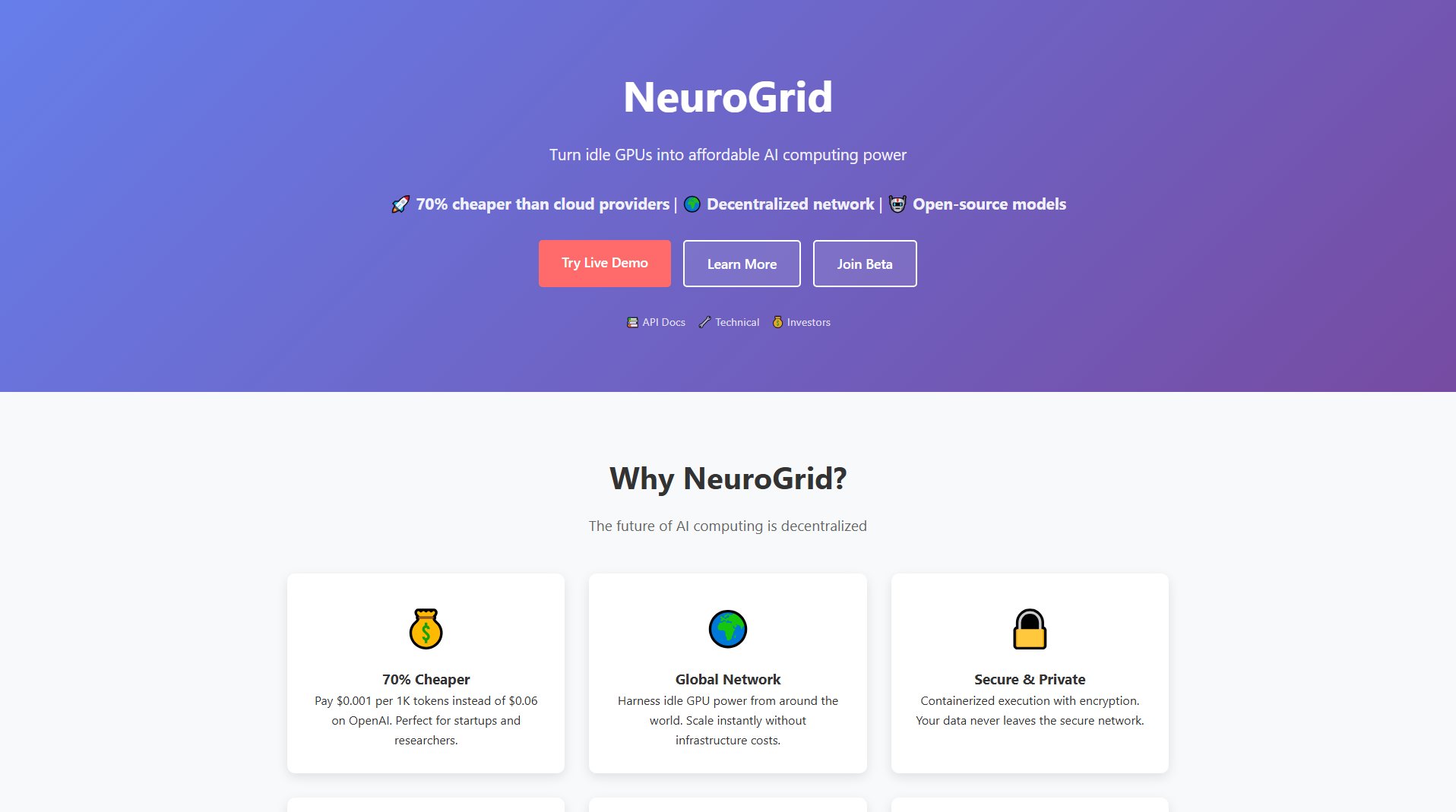NeuroGrid
Democratizing AI Computing with decentralized GPU power
What is NeuroGrid? Complete Overview
NeuroGrid is a decentralized AI computing platform that leverages idle GPU power from around the world to provide affordable, scalable, and secure AI model execution. It addresses the high costs and infrastructure limitations of traditional AI computing by offering a pay-as-you-go service that is 70% cheaper than alternatives like OpenAI. NeuroGrid is designed for startups, researchers, and developers who need cost-effective and flexible AI computing solutions. With support for open-source models like LLaMA, Mistral, and Stable Diffusion, NeuroGrid eliminates vendor lock-in and ensures privacy through containerized execution and encryption. Additionally, it allows GPU owners to monetize their idle hardware, creating a win-win ecosystem.
NeuroGrid Interface & Screenshots

NeuroGrid Official screenshot of the tool interface
What Can NeuroGrid Do? Key Features
Cost-Effective AI Computing
NeuroGrid offers AI computing at just $0.001 per 1K tokens, which is significantly cheaper than OpenAI's $0.06. This makes it an ideal solution for startups and researchers who need affordable access to powerful AI models without breaking the bank.
Global GPU Network
By harnessing idle GPU power from around the world, NeuroGrid provides instant scalability without the need for expensive infrastructure. This decentralized approach ensures high availability and reduces latency for users globally.
Secure & Private Execution
NeuroGrid ensures data privacy and security through containerized execution and encryption. Your data never leaves the secure network, providing peace of mind for sensitive applications and compliance with data protection regulations.
Open-Source Model Support
NeuroGrid supports a wide range of open-source models like LLaMA, Mistral, and Stable Diffusion, allowing users to avoid vendor lock-in and choose the best models for their needs. This flexibility is crucial for developers and researchers who require specific model capabilities.
GPU Monetization
GPU owners can turn their idle gaming rigs into passive income sources by contributing to the NeuroGrid network. This feature not only benefits users needing computing power but also creates an incentive for more participants to join the network.
Developer-Friendly Tools
NeuroGrid provides a simple REST API, comprehensive documentation, and SDKs for every programming language, making it easy for developers to integrate and start using the platform quickly. This focus on developer experience ensures a smooth onboarding process.
Best NeuroGrid Use Cases & Applications
Startup AI Development
Startups can leverage NeuroGrid's affordable AI computing to develop and test their AI applications without the high costs associated with traditional cloud providers. This allows them to allocate more resources to innovation and growth.
Academic Research
Researchers can use NeuroGrid to run complex AI models for their studies, benefiting from the platform's cost-effectiveness and support for open-source models. This democratizes access to high-performance computing for academic institutions.
Content Creation
Artists and content creators can utilize NeuroGrid to run models like Stable Diffusion for generating high-quality images and videos, all while keeping costs low and maintaining data privacy.
GPU Monetization
Individuals with powerful gaming rigs can contribute their idle GPU power to the NeuroGrid network and earn passive income. This is a great way to offset the cost of hardware while supporting the AI community.
How to Use NeuroGrid: Step-by-Step Guide
Sign up for an account on the NeuroGrid website to get started. The registration process is quick and straightforward, requiring only basic information.
Choose the AI model you want to use from the supported open-source models like LLaMA, Mistral, or Stable Diffusion. NeuroGrid provides detailed documentation to help you select the right model for your needs.
Integrate NeuroGrid into your application using the provided REST API or SDKs. The comprehensive docs and developer tools make this step easy, even for those new to AI computing.
Start running your AI tasks on the NeuroGrid network. The platform handles the scaling and execution, allowing you to focus on your application logic.
Monitor your usage and costs through the NeuroGrid dashboard. The transparent pricing model ensures you only pay for what you use, with no hidden fees.
NeuroGrid Pros and Cons: Honest Review
Pros
Considerations
Is NeuroGrid Worth It? FAQ & Reviews
NeuroGrid uses containerized execution and encryption to ensure that your data never leaves the secure network. This means your data is protected at all times, even during processing.
NeuroGrid supports a variety of open-source models, including LLaMA, Mistral, and Stable Diffusion. This allows users to avoid vendor lock-in and choose the best models for their needs.
By contributing your idle GPU power to the NeuroGrid network, you can earn passive income. The platform handles the distribution of tasks and ensures you are compensated for your contribution.
Currently, NeuroGrid operates on a pay-as-you-go model with no free tier. However, the cost is significantly lower than traditional providers, making it accessible to startups and researchers.
NeuroGrid provides SDKs for every major programming language, ensuring that developers can integrate the platform into their applications regardless of their tech stack.